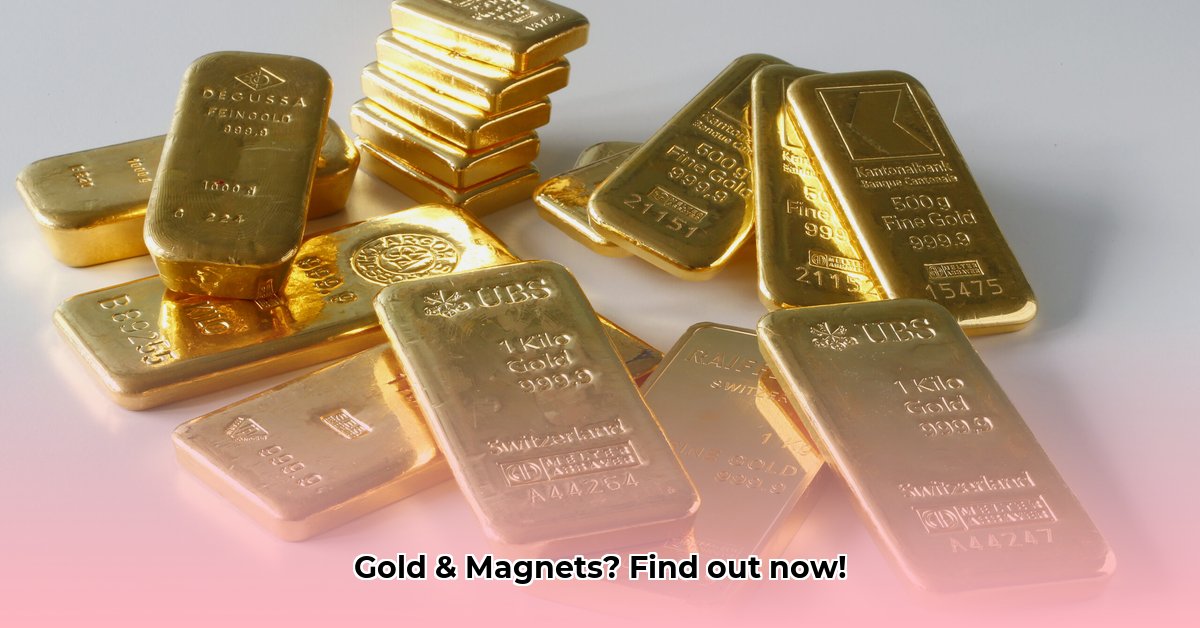Have you ever wondered if a magnet could help you tell real gold from a fake? It’s a common question, and while a magnet alone won’t give you a definitive answer, it can be a useful first step. For more on how magnets interact with other metals, check out this article on stainless steel magnetism. This guide will explain how magnets interact with gold, what that tells you about its purity, and how to combine that information with other tests. We’ll cover everything from simple visual checks to more involved tests, so you can feel confident in knowing whether that shiny piece is really worth its weight in gold.
The Science Behind Gold and Magnetism: Spotting Real vs. Fake Gold
Ever wonder if you can use a magnet to test if something is real gold jewelry? It’s a common question regarding precious metals, and the answer isn’t a simple yes or no. Let’s dive into why. We’ll explore the science behind it and give you some practical steps to help you figure out whether that glittering piece is the real McCoy.
Understanding the Magnetic Personality of Gold (or Lack Thereof!): Gold Purity
Pure gold, what we call 24-karat gold, exhibits a property scientists term “diamagnetic.” What does that fancy word mean regarding metallic properties? It simply means that pure gold very weakly repels a magnetic field. In other words, it won’t stick to your fridge magnet. But here’s the catch: most gold jewelry isn’t pure gold. It’s usually an alloy – a mix of gold with other metals. These buddies – like copper, silver, zinc, platinum or even nickel – can dramatically change how the gold reacts to a magnet. So, will your gold ring stick? Maybe, depending on what’s mixed in there. If there’s enough of a magnetic metal in the mix, it’ll probably stick. Remember, white gold often contains nickel, which can cause a magnetic attraction.
The Magnet Test: A Quick Check, Not a Guarantee of Gold Content
Using a magnet is a quick first step for jewelry testing. If a piece of gold jewelry strongly sticks to a magnet, it’s a pretty good sign it’s not pure gold or at least not mostly gold. However, if it doesn’t stick, that doesn’t automatically mean it’s real gold. Lots of things look like gold but aren’t magnetic. Think of it as a first screening – it narrows things down, but it doesn’t give you the final answer. It is also worth noting that the strength of a magnetic clasp may suggest more than just gold content by sticking to a magnet.
Going Beyond the Magnet: Other Ways to Check Your Gold for Authenticity
A proper gold authenticity check needs more than just a magnet. Let’s look at other reliable methods:
-
The Visual Inspection: A Look-See Investigation: Look closely for hallmarks – those tiny stamps that often show the karat purity (like 10k, 14k, 18k, 22k or 24k) and sometimes the maker’s mark. These indicate the percentage of gold present. A rich, deep yellow color usually points to higher karat gold. Be aware that hallmarks can be faked, or wear down over time. Also check for any signs of discoloration or wear that might reveal a base metal beneath a gold plating, especially on edges and clasps.
-
Acid Testing: A Risky Business (Proceed with Extreme Caution!): This method involves carefully applying a tiny bit of acid (usually nitric acid) to a hidden area of the gold item. Real gold won’t react (though the specific reaction will depend on the karat), but fakes might. Important: This is not for the faint of heart! It’s very easy to damage your piece, and nitric acid is dangerous, so this test is best done by professionals unless you really know what you’re doing and have the proper safety equipment. It’s definitely not something you want to try on that precious heirloom! And absolutely avoid this test on high-value items. You could ruin an expensive item with improper acid testing, or hurt yourself. This test is destructive.
-
Density Test: Weighing the Evidence: Gold is very dense (much denser than most common metals). Comparing the density of your item to the known density of gold for a given karat can help determine if it’s the real deal. Unfortunately, this test needs some specialized equipment, including a precise scale and a way to accurately measure volume (like water displacement), so it’s best left to the experts or very careful hobbyists. The density of gold is approximately 19.3 grams per cubic centimeter (g/cm³), but this varies based on the karat.
-
Scratch Test: Scratch the item across a ceramic plate. If it leaves a gold mark it is likely gold, if it leaves a black mark, it is likely another material.
-
Professional Appraisal: Leave it to the Pros: For really valuable pieces, or if you’re unsure after trying other methods, get a professional appraisal. These professionals (gemologists or certified appraisers) have access to advanced testing tools (like X-ray fluorescence (XRF) spectrometers, which can precisely determine the composition of the metal) and the expertise to give you a definitive answer. A professional can also assess the item’s overall condition, craftsmanship, and historical significance, providing a comprehensive valuation.
What Do the Results Mean? Decoding Gold Testing Clues
Here’s a simple guide to interpret your results. Remember, the most reliable results come from combining several methods:
| Test Result | Interpretation | Next Steps |
|---|---|---|
| Magnet Test: Sticks Strongly | Probably not pure gold. Other metals are present. | Visual inspection, and consider other tests such as acid or density testing (by a professional) |
| Magnet Test: Doesn’t Stick | Could be gold, but more tests are needed. | Visual inspection, consider professional acid testing. |
| Visual Inspection: Hallmarks Present | Suggests authenticity, but further confirmation might be needed. | Consider more tests for higher confidence. |
| Visual Inspection: Discoloration or wear | Plated or filled gold, not solid. | Further testing not usually needed to confirm it’s not solid gold. |
| Acid Test: No Reaction | Consistent with gold – a strong indication of authenticity. | Often considered sufficient, particularly if combined with a visual inspection. |
| Acid Test: Reaction | Not gold, or a lower karat than expected. | N/A |
| Density Test: Matches Expected Value | Strong evidence of authenticity. | Can be used to confirm karat. |
| Density Test: Significantly Lower | Fake or low-quality gold. | N/A |
| Scratch Test: Gold Mark | Likely Gold | Not Gold |
| Professional Appraisal: Authenticated | Item confirmed as genuine gold. | N/A |
The Bottom Line: Multiple Tests for Peace of Mind
Will gold stick to a magnet? The answer is nuanced: it depends. Using multiple methods gives you the best chance of knowing for sure whether your gold is the genuine article. Don’t count on just one test, and absolutely get a professional appraisal for those precious, high-value items. Remember, even simple tests, like the magnet test and visual inspection, can offer clues if you approach them thoughtfully.
Unveiling Gold Authenticity: How to accurately test 14k and 18k gold for authenticity using a magnet and other methods
Key Takeaways:
- A magnet won’t stick to pure gold; this is due to gold’s diamagnetic properties.
- Alloying metals in 14k and 18k gold can affect magnetic attraction, so a magnet test alone isn’t conclusive.
- Visual inspection for hallmarks is crucial but can be faked.
- Multiple tests are needed for reliable confirmation of authentic gold.
- Professional appraisal is recommended for high-value pieces.
The Magnet Test: Fact vs. Fiction in Determining Karat Value
Let’s start with the magnet test. Will a magnet stick to gold? Pure gold, surprisingly, is slightly repelled by magnets, a property called diamagnetism. But 14k and 18k gold aren’t pure. They’re alloys—mixtures of gold with other metals like copper, silver, zinc, or palladium. These alloying metals can influence magnetic behavior. White gold may contain nickel. So, if your gold piece is attracted to a magnet, it’s probably not real gold—or at least, not the karat it claims to be, suggesting it is gold plated or has a significant amount of iron or nickel. However, the absence of magnetic attraction doesn’t guarantee authenticity. Many non-magnetic metals can be used in counterfeits.
Beyond the Magnet: Other Tests for Authenticity of Gold Items
The magnet test offers a quick initial check, but it’s not the whole story for jewelry assessment. Here’s where you should go next for metal verification:
1. Visual Inspection: Look for hallmarks, those tiny markings indicating the karat (10k, 14k, 18k, etc.). These are often stamped on
- Why an App Appeared on My Phone Unexpectedly - November 22, 2025
- How to Stop Unwanted Apps from Automatically Downloading on Android - November 21, 2025
- Why Are Android Games Installing Themselves on Your Phone? - November 20, 2025










